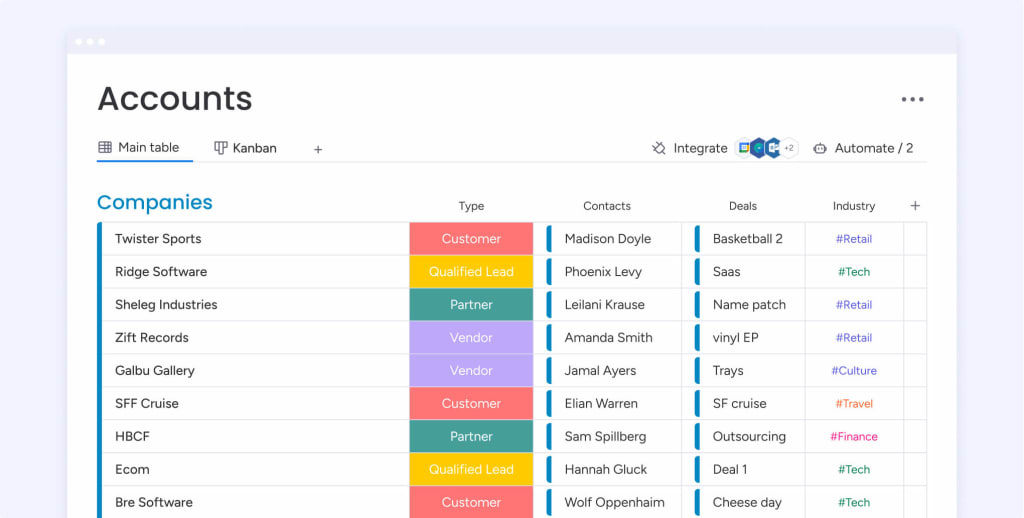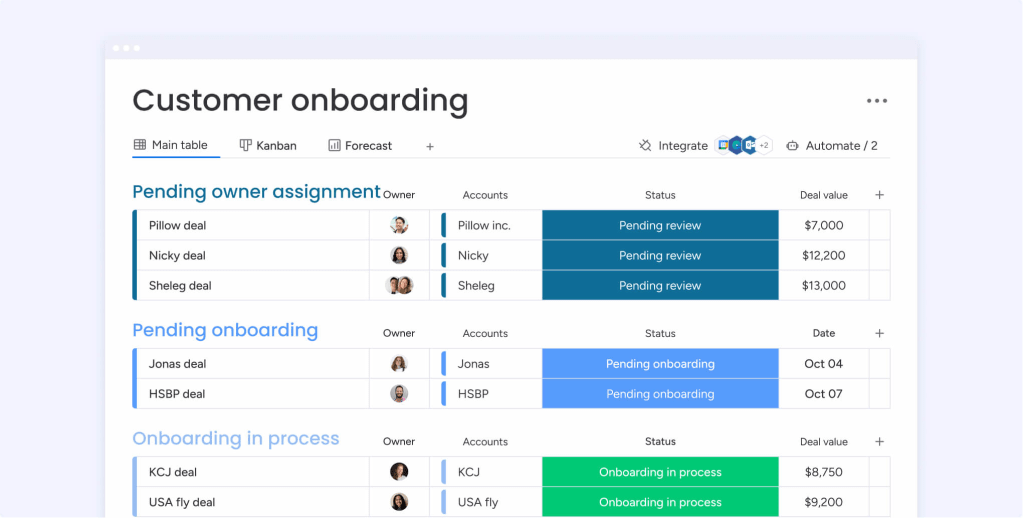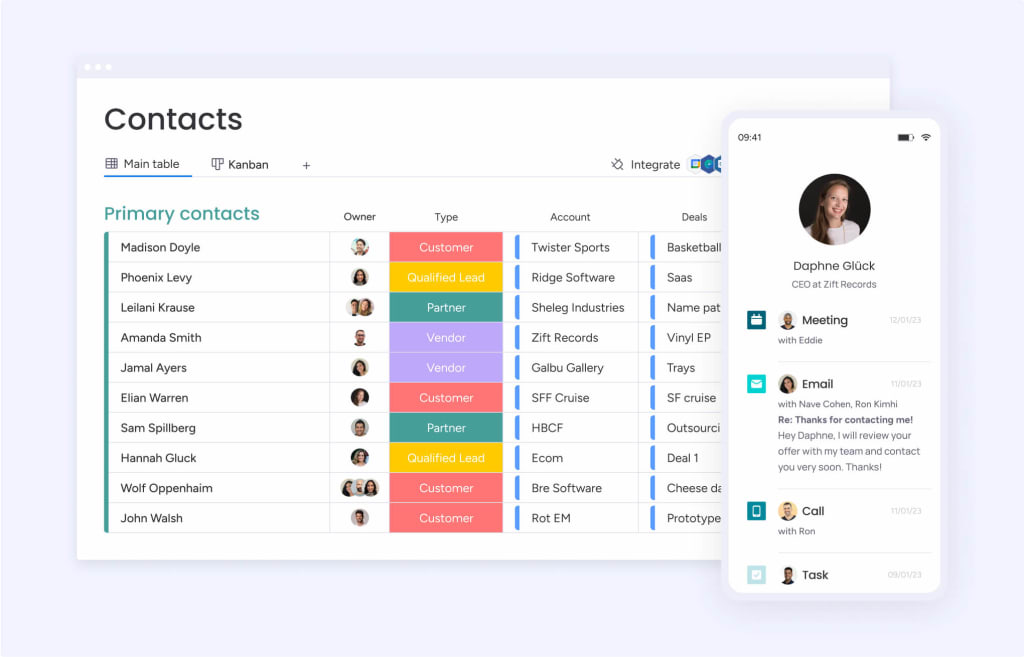“Every company’s greatest assets are its customers,” says author Michael LeBoeuf, “because without customers there is no company.” This notion is at the core of being a customer-oriented business.
Customer orientation means putting your customer’s needs first. While many businesses focus on sales, customers can be put off by a company that is less interested in their needs than meeting those sales targets.
If you focus on attracting customers rather than chasing sales, the sales will come to you. In other words, done right, a customer orientation approach is a win-win.
In this article, we’ll take a deep dive into why customer orientation is good for business. We’ll look at the benefits—and challenges—of adopting a customer-centric approach. We’ll explore how to build a customer-oriented business, and show you how monday sales CRM can support your customer orientation.
Try monday sales CRMWhat is customer orientation?
Customer orientation, also known as customer-centricity or customer focus, is an approach to managing your business by placing the customer at the center of every business activity and decision. Customer-oriented companies understand and prioritize the needs, wants, and preferences of their customers to create value and deliver exceptional experiences.
Done right, customer orientation can lead to long-term customer retention, a great reputation, and sustainable business growth. According to HubSpot, “Customer-centric companies are 60% more profitable than companies that aren’t.”
The role of customer service in a customer-oriented organization
Customer service teams are vital in delivering the customer orientation strategy. They are the ones at the frontline, with a direct connection with your customers. The quality of the service they deliver shapes customers’ opinion of the company.
When it comes down to it, it is your customers themselves who will decide whether you are truly a customer-oriented business or not. Their experience with that one customer service contact point can make all the difference. In fact, research by McKinsey has found that improving the customer experience boosts sales revenue by up to 7%.
Read also: Customer support vs customer service
Why is customer orientation important?
Here are 3 major benefits of adopting a customer-centric approach:
1. It’s more cost-effective
According to HubSpot, it’s five times more expensive to acquire a new customer than to retain an existing one. But if you can keep customers happy and satisfied, they stay with you. They may even send more customers your way. The customer lifetime value (CLV) of a satisfied client makes that acquisition cost worth it.
2. It can increase customer loyalty
To take a customer-oriented approach, you need to know what your customers want, need and expect. Gathering this useful data about your customers means that you are better able to service those needs, and even predict them. As a result, your customers are more likely to remain faithful to your brand, even if new competitors enter the market.
3. It can lead to more customers through referrals
Satisfied customers not only stay loyal to your company, they can also act as ambassadors for your brand. If they’ve received great service, they’re more likely to recommend you to others, sending new customers your way and further helping to limit those customer acquisition costs. Gartner found that a good customer experience leads to an 82% probability of customers making a repeat purchase or renewal, and a 97% chance of them recommending the company.
Common challenges to becoming customer-oriented
What keeps companies from becoming customer-centric? Businesses may struggle to adopt a customer orientation approach for a number of reasons:
- Lack of buy-in from leaders: C-suites and management teams that are more sales-oriented may resist a customer-centric approach for fear of hurting profitability.
- Inconsistency across departments: Departmental silos can make it harder to implement a common customer-centric strategy across the company. For example, an IT team that’s more focused on the tech than the customer experience might develop an app interface that isn’t user-friendly.
- Disengaged employees: Two-thirds of US employees are disengaged at work. Disengaged employees are less likely to provide exceptional customer service because they are more inclined to put in minimal effort or show a negative attitude.
- Poor customer knowledge or data: Companies who lack the awareness, deep understanding, and analytics about their customer base will struggle to deliver.
6 steps to becoming a customer-oriented business
So how do you overcome those obstacles and achieve the benefits of being a customer-oriented business? Here are 6 steps to take:
1. Get to know your customers
Establish a customer relationship management process to find out what your potential and existing customers are interested in and what they want from your business. Lead capturing forms, pop-ups and surveys can help you identify new leads that fit your ideal customer profile, and allow you to tailor your communications to address their interests and needs.
Taking the time to build a great lead management strategy can help increase revenue by 133%. People are more likely to trust and buy from a company that focuses on them rather than on their own profits.
2. Engage your customers with great content
Create and publish valuable, engaging content, such as blog articles, social media posts, and offers, that address and solve your customers’ challenges and problems. SEO-optimized content that targets the specific keywords and phrases your prospects are searching for means that your content can appear at their point of need—on the search engine results page (SERP) when they are searching for solutions.
3. Build a customer-centric culture within your organization
A customer orientation approach is not simply for your customer service and sales teams. It should be at the heart of all the business does:
- Your products and services should be developed to serve customer needs and expectations.
- Your software and app interfaces should be designed with the customer experience (CX) in mind.
- Your marketing and customer services should focus on solving customer problems.
- Your HR teams should hire and train for cultivating great customer relationships.
4. Implement customer feedback systems
Listening to, and acting on, feedback is vital for customer satisfaction and retention. Gathering and analyzing customer feedback improves customer loyalty and retention. Use a CRM system like monday sales CRM to gather and centralize your customer insights. Give your customers easy and engaging ways to provide feedback, such as gamified surveys and quizzes, Net Promoter Scores (NPS), online reviews and so on.
5. Create personalized customer experiences
It’s important to have a thorough understanding of your customer base and profiles, yet at the same time be able to treat each of the customers who fit those profiles as valued individual customers.
For example, with monday sales CRM, you can easily personalize your email communications with your customers by adding in their names automatically. What’s more, automated notifications let you know when they open an email, so you can manage the customer relationship more effectively.
6. Use customer data to drive decision making
A good CRM solution should give you clear and actionable insights into your customer profiles and audiences, categorize and segment your customer data, and automate analysis.
Use this data to tailor and iterate your customer orientation so that you can stay on top of customers’ changing interests and needs.
Measuring and Evaluating Customer Orientation
How can you know if you’re truly customer-oriented? Depending on your business, there may be many different metrics you’ll want to capture, analyze and understand, but there are a few that are really key:
- Customer retention score: How loyal are your customers? How long have they been with you and how well are you doing at keeping them, and keeping them satisfied? Tracking customer retention is vital to understand if you are to measure the ROI of your customer orientation efforts.
- Customer satisfaction score: How happy are your customers with their experience? Customer surveys are a great way to get a quick snapshot of customer satisfaction immediately after an interaction. This could incorporate a mix of quantitative and qualitative questions, including Likert scale (strongly agree to strongly disagree) questions, and open, feedback questions.
- Net Promoter Score: This metric tracks how likely it is your customers will recommend your business to someone else. This can be captured with a single survey question: “On a scale of 1 to 10, how likely are you to recommend us to a friend?” Customers who score you 9 or 10 out of 10 are promoters, while 6 and under are considered detractors.
- Top performing reps: Identifying your best customer service performers means you can recognize and reward their achievements, and incentivize others to model their behavior. In this way, you can make customer orientation part of the culture of the business.
Examples of customer-oriented companies
When you think of the words “customer orientation,” a few famous brands come up again and again:
Apple: Apple has a reputation for knowing what its customers want before their customers know what they want. Steve Jobs once said that their philosophy was to “start with the customer experience and work backwards from there.” By putting the customer first, they’ve built a world-class reputation for intuiting future customer needs and designing user-friendly products that delight their customers.
Four Seasons: The luxury hotel chain has been customer-centric from the beginning, famously never saying no to a (legal!) customer request. Their reputation is strengthened by a level of customer service that most brands can only dream of — whether that’s putting starch in each hotel room as well as an iron, to spotting that a customer would need a projector for their presentation before the customer themselves had noticed they needed one.
Deezer: Music streaming service Deezer offers listeners 56 million songs, podcasts and audiobooks. Deezer has a team of editors around the world to understand local music tastes that will serve customers wherever they are. Deezer uses monday sales CRM to send users music recommendations, notes and tips that are localized and personalized. Using dashboards the Deezer team can test and run campaigns, analyze results and iterate based on how their users react to those campaigns.
Try monday sales CRMHow monday sales CRM can help you build a customer-centric process
monday sales CRM makes it easy to be a customer-centric business. It lets you bring all your customer data into a single, intuitive, no-code interface, so you can:
- Get to know exactly who your customers are and what they need, with our handy pre-built Accounts dashboard. The Accounts dashboard gives you an overview of which industry your clients are in, the deal you are working on, the status of that deal, and the contact person, all in a user-friendly visual interface. That way, you can keep track of each account, remember details so you can personalize your emails and calls, and keep your customer information organized.

- Give each new customer the white glove treatment with the Customer Onboarding dashboard, which lets you create a personalized experience and make sure that every new customer has the information they need to succeed with your products.

- Keep all your contact information in the same place so you can keep track of the conversations with your customers, make sure you don’t repeat yourselves, and show them that you’re paying attention.

A customer orientation approach—putting the customer at the heart of how you do what you do—is your key to a happy, satisfied, and loyal customer base. Instead of chasing sales, put effort into understanding your customers’ needs and expectations, and provide solutions to meet them. Your customers will come to you. They’ll want to stay. And they’ll send more customers your way.

